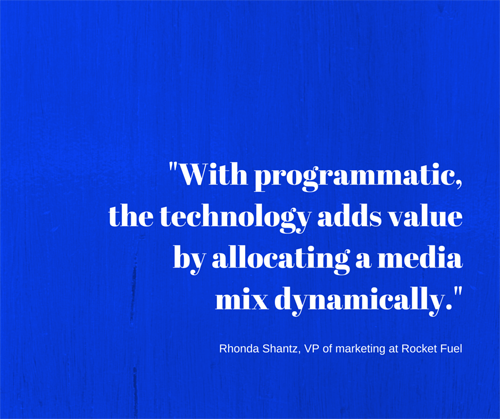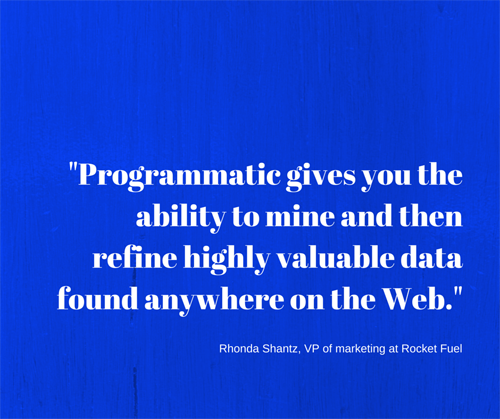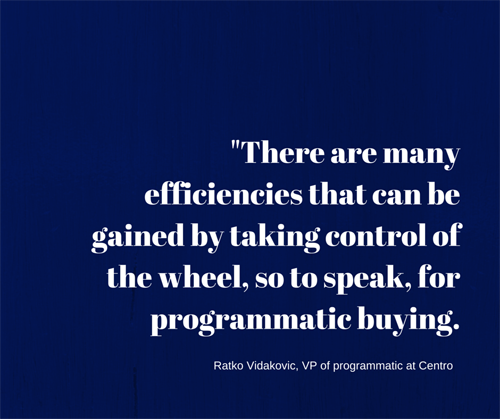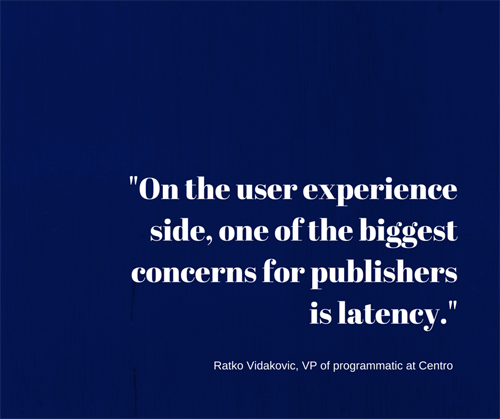Quick Hit: How Programmatic Works

While often talked about in today's digital advertising ecosystem, programmatic isn't always understood.
Since programmatic revenues are totaling in the tens of billions (and comprising roughly 45 percent of digital ad spend), it's important those acquiring and retaining customers online have some familiarity with programmatic.
In a thorough study, IAB defined programmatic as, "machine-based buying and selling of digital media including auction-based methods like RTB and private marketplaces as well as the automation of direct sales, sometimes called programmatic direct."
For help breaking down programmatic further, Website Magazine reached out to leaders in the field to provide their thoughts on the growing market. Asked the same questions, their insights provide different but equally valuable insights.
Rhonda Shantz, VP of Marketing at Rocket Fuel
If the least tech savvy person you know asked you how programmatic works, how would you answer?
 In the days of "Mad Men," decisions about where a marketer's ad would appear might be made over the course of months, or even years. Fast forward to today, with programmatic marketing, the decisions about ad placements can be automated by technology and made in milliseconds, at an unbelievable rate of 36 billion decisions per second, across the world.
In the days of "Mad Men," decisions about where a marketer's ad would appear might be made over the course of months, or even years. Fast forward to today, with programmatic marketing, the decisions about ad placements can be automated by technology and made in milliseconds, at an unbelievable rate of 36 billion decisions per second, across the world.
Let's put the velocity and volume of programmatic in perspective: A traditional digital marketer not using programmatic technology scans data for insights to guide his decision-making in where to place an ad. To start, he combines the 112 demographic combinations of gender, age, and household income segments with the 210 DMAs in the United States to create 23,520 possible combinations. While it took him hours to configure, his competitor used programmatic technology to accomplish the same task during his first sip of coffee.
At Rocket Fuel, our programmatic approach focuses on delivering our client's marketing campaigns at the precise moment of influence to reach a consumer, using a process called Moment Scoring, which predicts the likelihood that a consumer will respond favorably to an ad and will take action. Moment Scoring works by filtering through and scoring over 11 million attributes, including device type, time of day, location and interests, all of which offer incredible insight into consumer intent.
What are the top two opportunities available for advertisers using programmatic?
Drive Higher ROI.
The overwhelming advantage that programmatic offers to advertisers is improved marketing ROI, often in the form of superior campaign performance. Programmatic marketing technology with artificial intelligence (AI) learns over time, as more attributes are tested and greater knowledge of what works and does not work for a specific campaign is attained. As a result, an advertiser's CPA (cost per acquisition) will decrease and their digital marketing dollars will go further. In many cases, by executing a cross-device campaign (one that automatically optimizes to deliver the right ad, to the right person at the right moment on whatever device they are using), a marketer might see performance improve by 30 percent, or uncover 20 percent additional conversions.
Optimize marketing dollars automatically.
The old way of buying advertising meant setting a predetermined spend by a specific channel, such as social, display or video. With programmatic, the technology adds value by allocating a media mix dynamically. The technology learns in real-time what's working and what isn't, and adjusts marketing spend accordingly - offering better performance automatically. Marketers can reduce waste by spending their budget with an intelligent platform that finds an efficient and effective balance of retargeting, prospecting, and conquesting.

What are the top two concerns publishers have about programmatic and should they be concerned?
"I can't monetize my first party data fast enough to keep pace with advertiser demand."
In a recent "State of the Publisher Industry" report we completed with Digiday, our survey found that 94 percent of advertisers allocate budget to plans featuring audience extension, yet only 47 percent of publishers are realizing revenue from plans featuring audience extension. Advertisers are allocating a higher share of their budget to programmatic sources, yet not all publishers are moving fast enough with their programmatic solutions to capture revenue from the budget shift. The good news is that programmatic technology can serve as the great equalizer; audience extension solutions are designed to quickly scale and optimize an ad seller's audience and monetize data outside of their own site traffic.
"I don't understand what's in it for me."
One of our partners, AdMonsters, has said that publisher first-party data is the oil of the digital advertising industry - a highly valuable substance in limited supply just waiting to be tapped. Just like the oil industry, the value isn't in drilling and obtaining data, but in the refinement process.

What's Rocket Fuel's role in the programmatic ecosystem?
Rocket Fuel's technology is at the center of the digital media ecosystem. Our mission is to enhance all forms of media through Moment Scoring technology that makes every media dollar go further by targeting precisely the moments where consumers are most receptive to a marketer's message. We've worked with 96 of the top 100 advertisers, and partner with some of the world's leading CRM and marketing platforms.
Our superior AI decisioning, identity management capabilities and big data infrastructure combine to create a unique platform designed to accurately predict the moments when marketing messages are most likely to resonate with a consumer regardless of device, channel, or tactic. Forrester concluded in a 2015 Total Economic Impact Survey of our platform that "not only did the implementation of the Rocket Fuel platform more than pay for itself in short order, but it also produced millions of dollars in savings almost immediately, lowering clients marketing costs significantly."
Ratko Vidakovic, VP of Programmatic at Centro
 If the least tech savvy person you know asked you how programmatic works, how would you answer?
If the least tech savvy person you know asked you how programmatic works, how would you answer?
I would say that programmatic advertising is very similar to the way the financial markets evolved in the last decade. More specifically, I'm talking about going from human-to-human transactions to computer-to-computer transactions. Stocks, for example, used to be transacted was via phones calls and human relationships. Today, it's primarily done via Bloomberg Terminals and eTrade software - in some cases completely automated by computers.
Advertising is going through a similar transformation. It used to be advertisers calling up website owners and negotiating the purchase of ad space, at which point another person manually executes the order on behalf of the advertiser. With programmatic advertising, that same ad space is now being bought directly by advertisers through software products -- never needing to interact with the publisher.
What are the top two opportunities available for advertisers using programmatic?
The top opportunity is the ability to activate their own in-house customer data. This goes beyond just website data, which is also incredibly valuable. But I think the most unrealized data source is CRM data (e.g., email addresses), which can now be translated into targetable audience data for use in programmatic ad campaigns. The second opportunity is the ability to take programmatic advertising in-house. With the evolution of DSPs (demand side platforms), they've become easier than ever to run programmatic campaigns alongside other channels like search and social, which are often found in house. Fundamentally, they are all executed and optimized similarly.

What are the top two concerns publishers have about programmatic and should they be a concern?
The top two concerns, from my perspective, is revenue maximization and user experience. With regards to maximizing revenue, publishers have many challenges. For examples, getting more private marketplace deals activated and spending; or monetizing international inventory effectively; or managing header bidding technologies. All are examples of legitimate concerns that affect revenue. On the user experience side, one of the biggest concerns for publishers is latency. The more ad tech scripts are added to their sites, the higher the latency and the poorer the experience for site visitors. And with the widespread proliferation of header bidding technology, this concern is not only valid, but is becoming increasingly important to publishers.

What's Centro's role in programmatic?
Centro has various roles in the programmatic space. First and foremost, Centro has a multi-channel DSP, which allows marketers, agencies, and even publishers, to plan, execute, and optimize programmatic ad campaigns. Centro also has a strong services division, where programmatic campaigns are fully managed for clients. And lastly, there is the Centro Brand Exchange, which is a premium ad exchange, and one of the highest-rated supply sources in terms of quality in the Pixalate Seller Trust Index.

Subscribe to Our Newsletter!
Latest in Marketing








